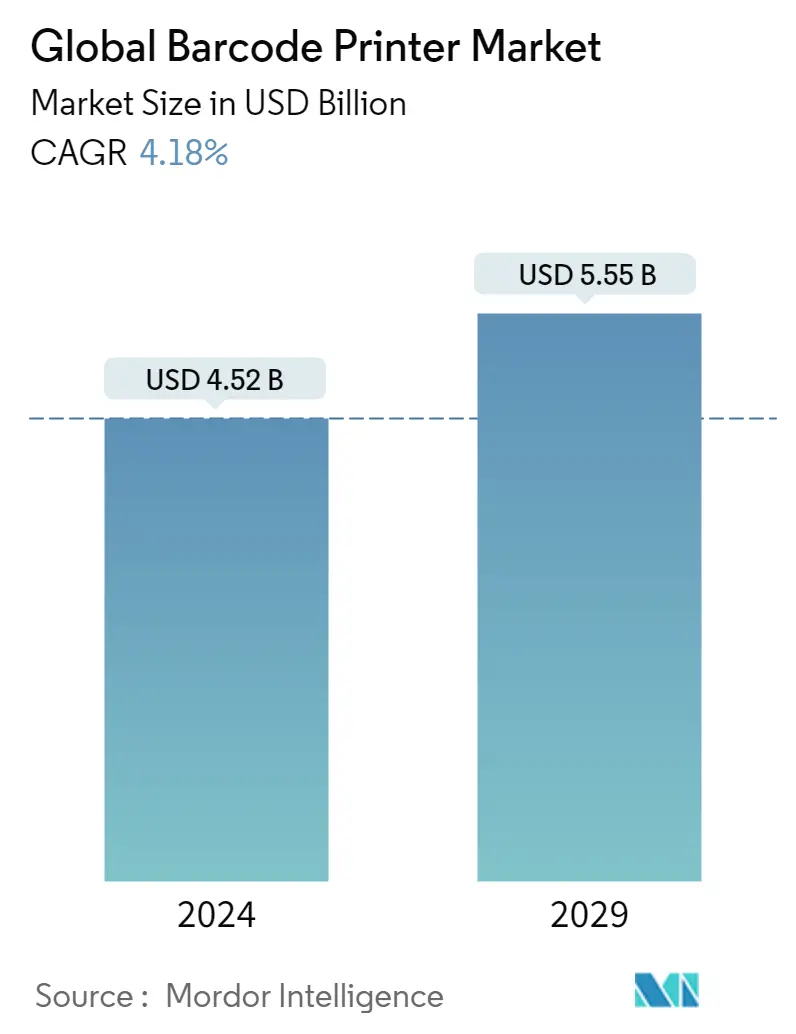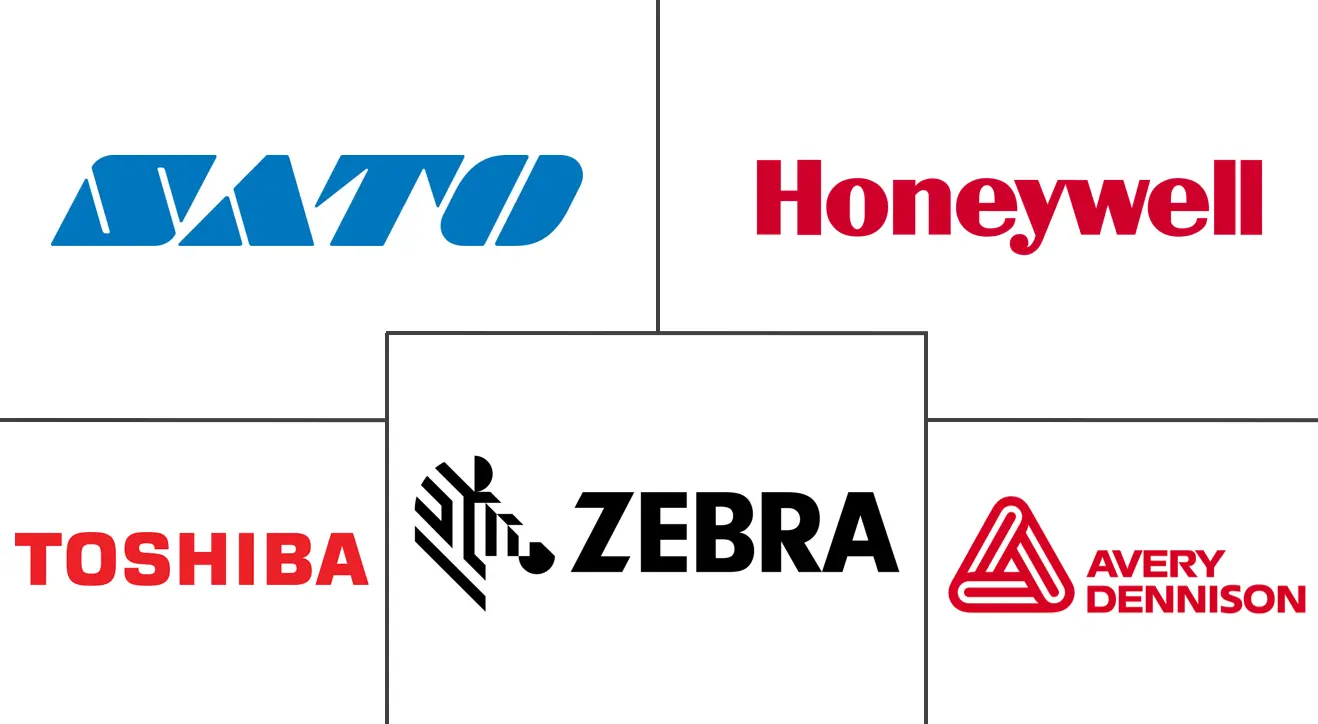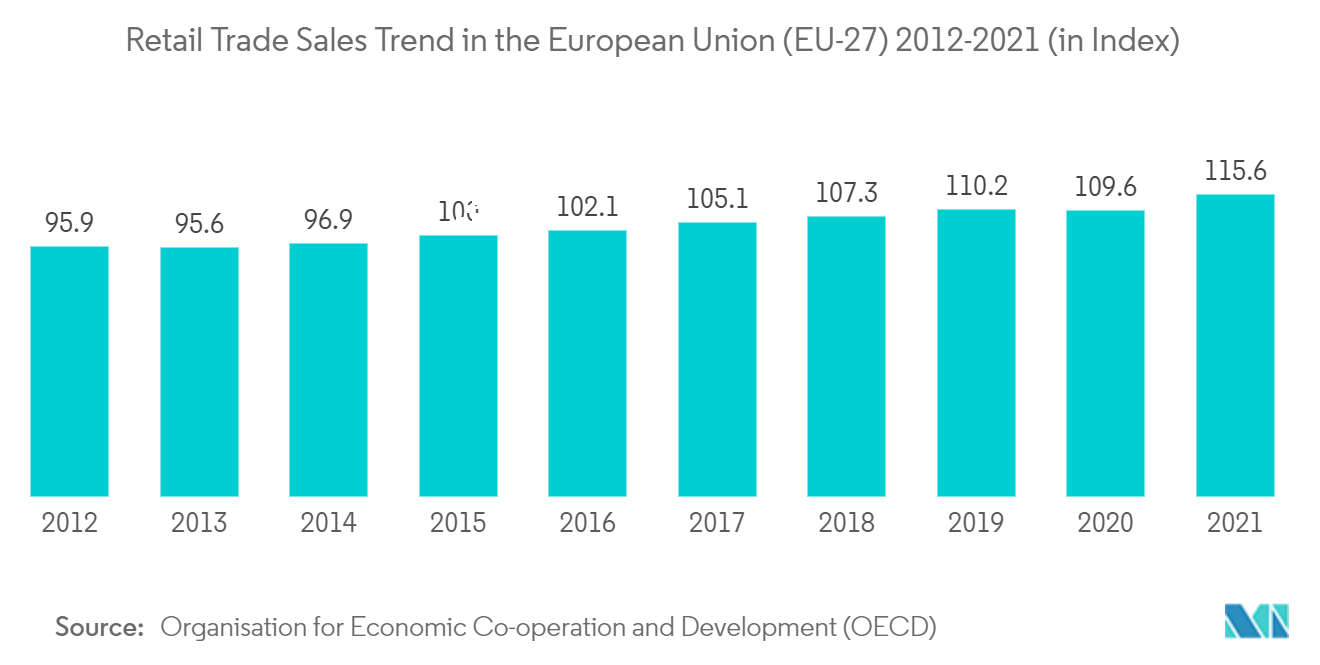Barcode Printer Market Size

| Study Period | 2019 - 2029 |
| Market Size (2024) | USD 4.52 Billion |
| Market Size (2029) | USD 5.55 Billion |
| CAGR (2024 - 2029) | 4.18 % |
| Fastest Growing Market | Asia Pacific |
| Largest Market | North America |
Major Players
*Disclaimer: Major Players sorted in no particular order |
Barcode Printer Market Analysis
The Global Barcode Printer Market size is estimated at USD 4.52 billion in 2024, and is expected to reach USD 5.55 billion by 2029, growing at a CAGR of 4.18% during the forecast period (2024-2029).
The growth of asset tracking applications and increasing technological advancements in printing and printer technology are some of the major factors driving the growth of the global barcode printer market. Many industries are adopting labels and barcodes for their asset tracking and providing information about their products.
- By product type, industrial printers are expected to account for the major market share over the forecast period. However, recent technological advancements, like wireless connectivity, are also boosting the mobile printer segment. Thermal barcode printers are extensively used across small and large enterprises to label and subsequently track the products shipped.
- The rising adoption of automatic identification and data capture technologies for enhancing productivity, along with the growing concerns regarding product safety and anti-counterfeiting, is also boosting the market for thermal printers. The increasing utilization of thermal printing technology in the latest on-demand printing applications further increases the scope of thermal barcode printers.
- Furthermore, the direct thermal technology that produces images using heat on a heat-sensitive substrate primarily serves the retail market, mainly for catchweight food labeling. It offers easy-to-use and reliability for short-life applications and delivers good low-cost barcodes at reasonable print speeds. These characteristics make direct thermal technology a choice for transit product identification and tracking labels, for example, for parcel distribution and outer case and pallet markings.
- Increased e-commerce resulted in an increased demand for barcode printing. This was satisfied through various efforts made by vendors and market investors alike. The development has been widespread, with interests ranging from printing barcodes to barcoding postage stamps to minimize wastage. Sometimes, a barcode is printed outside the booklet to identify the stamp barcodes inside.
- In July 2021, International Security Printers (ISP) invested in advanced hybrid printing, finishing, and inspection systems to further the development of barcoding postage stamps. The investments are diversified toward enabling postal authorities to add distinctive color-coded barcodes to stamps, placed along the stamp and separated by a perforation line.
- Moreover, with the onset of the COVID-19 pandemic, the studied market is further expected to propel demand, with healthcare increasing in demand. Furthermore, with several regions operating in lockdown, e-commerce sales are surging at an unprecedented rate, thus boosting the studied market.
Barcode Printer Market Trends
This section covers the major market trends shaping the Barcode Printer Market according to our research experts:
Retail Market is Expected to Witness the Largest Share
- The availability of inventory and an effective supply chain from e-commerce to brick-and-mortar stores is essential. According to the US Department of Commerce, retail sales are expected to reach 27.73 trillion by the end of 2020. The above number is only likely to increase owing to the global expansion of easily accessible e-commerce and mobile platforms, thereby fueling market growth over the forecast period.
- The barcodes enable the retailers to keep track of inventory, automate product re-ordering, compare sales of similar products of national brands vs. private labels, track product attribute preferences such as color, size, etc., customize targeted promotions based on customer buying habits, and identify what buying preferences a particular customer has.
- The two most widely accepted formats of retail barcodes globally are the EAN-13 (International Article Number) and UPC-A (Universal Product Code). GS1 provides a unique 12-digit UPC (Universal Product Code) or EAN company identification number that has to be entered into a UPC-A or EAN-12 barcode on your product's label. This is expected to make the players in the retail industry comply with such standards, fueling the market growth over the forecast period.
- Some of the industry's prominent players to cater to such requirements are coming up with product developments that enable them to boost the market growth. For instance, in December 2021, myBillBook, the Bengaluru-based fintech FloBiz announced the launch of its Point-of-Sale Billing solution for retailers and franchises. The retail industry accounts for 10% of India's GDP. Keeping this industry's scale and specific needs in mind, the solution has been designed to provide a faster billing experience using keyboard shortcuts and barcode scanning.

North America Is Expected to Hold Largest Market Share
- North America is one of the major investors and innovators in the market studied, owing to the high adoption rate of barcodes and labels across various industries. Moreover, the growing end-user industries in the region provide massive opportunities for vendors to invest in the regional market. Many of the significant market vendors are mainly from the United States. Hence, the region also has a high rate of innovation in the market studied.
- The massive growth of the e-commerce industry and the number of online shoppers have increased the need for customized and personalized marketing strategies. According to the US Census, the e-commerce boom revolutionizing the retail sector is expected to boost retail sales significantly. It also suggested that US retail sales increased by 13.1% in November 2021, compared to the same period in 2020, and online sales increased by 6.6%. The growth in e-commerce retail sales is further expected to increase the need for automated and advanced marketing procedures, thereby increasing the demand for ABM solutions.
- Similarly, in 2021, there were over 27 million e-commerce users in Canada, accounting for 72.5% of the Canadian population. According to the government's data, this is expected to increase to 77.6% in 2025. This is expected to create a massive demand for barcodes and labels. Additionally, Amazon launched its transparency program in the country to serialize the products sold on its platform by using a T-shaped QR-style tag to identify counterfeit items.
- The Canadian Food Inspection Agency, in December 2016, made amendments to nutrition labeling, which mandated the regulated parties to meet the new labeling requirements within a five-year transition period, during which they must comply with either the former or the new requirements. Such regulatory initiatives are expected to increase the use of barcodes and labels in consumer-packaged foods over the coming years.
- Moreover, the US Department of Agriculture (USDA) adopted Digimarc Barcodes as an approved digital disclosure method for packaging containing bioengineered food, commonly known as genetically modified organisms (GMOs). Digimarc Barcode is a new-generation visually imperceptible barcode, which can be added to product packaging, retail labels, and hangtags. It may be scanned by compatible consumer phones, retail barcode scanners, and computer vision systems. It also eliminates the need to add a QR method to the product package design and fulfills the new federal regulations.

Barcode Printer Industry Overview
The competitive rivalry in the barcode printer market is high owing to some key players such as Zebra Technologies Corporation, and Avery Dennison Corporation, amongst others. Their ability to continually innovate their offerings has allowed them to gain a competitive advantage over their competitors. Through strategic partnerships and mergers and acquisitions, these players are expected to gain a strong foothold in the market.
- December 2021 - Honeywell launched its IMPACT series of barcode printers under the "Make in India" initiative. The four-inch desktop barcode printer is built for light-duty label printing requirements, and it supports thermal transfer/direct thermal printing, thereby enabling printing at 127mm/sec. IMPACT by Honeywell is a brand established specifically to cater to the growing mid-segment market in India.
- March 2021 - Brother Mobile Solutions announced the expansion of the Brother Titan Industrial Printer series with five enhanced four-inch industrial barcode label printers featuring internal rewinders for an increased use range. Built with metal, the portfolio includes an increased ribbon capacity, dual Wi-Fi/Bluetooth option, and PLC integration. The augmented range delivers clear barcode labels up to 600 dpi1 at speeds nearing 14 ips2.
Barcode Printer Market Leaders
-
Zebra Technologies Corporation
-
Avery Dennison Corporation
-
Honeywell International Inc.
-
Sato Holdings Corp
-
Toshiba Tec Corp
*Disclaimer: Major Players sorted in no particular order
.webp)
Barcode Printer Market News
- January 2022 - MUTOH America launched a new eco-solvent roll-to-roll printer. The 54" XpertJet 1341SR Pro features MUTOH's AccuFine print head, VerteLith RIP software, and i-screen technology. The media tracker prints a barcode on the end of the media so that the printer is expected to read the barcode and recognize the quantity remaining on the media roll when it is loaded on the printer again.
- December 2021 - FloBiz launched its POS billing solution, myBillBook, for retailers and franchises, with the added functionality to print barcodes as per the respective sale complemented by the existing functionality of scanning them. Such POS solutions could enable non-contact applications, thereby reducing any possible virus spread.
Barcode Printer Market Report - Table of Contents
1. INTRODUCTION
- 1.1 Study Assumptions and Market Definition
- 1.2 Scope of the Study
2. RESEARCH METHODOLOGY
3. EXECUTIVE SUMMARY
4. MARKET INSIGHTS
- 4.1 Market Overview
- 4.2 Industry Value Chain Analysis
-
4.3 Industry Attractiveness - Porter's Five Forces Analysis
- 4.3.1 Bargaining Power of Suppliers
- 4.3.2 Bargaining Power of Consumers
- 4.3.3 Threat of New Entrants
- 4.3.4 Intensity of Competitive Rivalry
- 4.3.5 Threat of Substitute Products
- 4.4 Assessment of the Impact of COVID-19 on the Market
5. MARKET DYNAMICS
-
5.1 Market Drivers
- 5.1.1 Growing Technological Advancement
- 5.1.2 Rapid Growth of E-Commerce and the Logistic Sector
-
5.2 Market Restraints
- 5.2.1 Printing Quality
6. MARKET SEGMENTATION
-
6.1 By Product Type
- 6.1.1 Desktop Printer
- 6.1.2 Mobile Printer
- 6.1.3 Industrial Printer
-
6.2 By Printing Type
- 6.2.1 Thermal Transfer
- 6.2.2 Direct Thermal
- 6.2.3 Other Printing Types
-
6.3 By End-user Industry
- 6.3.1 Manufacturing
- 6.3.2 Retail
- 6.3.3 Transportation and Logistics
- 6.3.4 Healthcare
- 6.3.5 Other End-user Industries
-
6.4 By Geography
- 6.4.1 North America
- 6.4.2 Europe
- 6.4.3 Asia-Pacific
- 6.4.4 South America
- 6.4.5 Middle-East and Africa
7. COMPETITIVE LANDSCAPE
-
7.1 Company Profiles*
- 7.1.1 Sato Holdings Corp.
- 7.1.2 Zebra Technologies Corporation
- 7.1.3 Honeywell International Inc.
- 7.1.4 Toshiba Tec Corp.
- 7.1.5 Avery Dennison Corporation
- 7.1.6 Seiko Epson Corporation
- 7.1.7 TSC Auto ID Technology Co. Ltd
- 7.1.8 Primera Technologies Inc.
- 7.1.9 Brother Mobile Solutions Inc
- 7.1.10 Postek Electronics Co. Ltd
8. INVESTMENT ANALYSIS
9. FUTURE OF THE MARKET
** Subject To AvailablityBarcode Printer Industry Segmentation
A barcode printer is a computer peripheral for printing barcode labels or tags that can be attached to or printed directly on physical objects. This report segments the market by type (desktop printer, mobile printer, industrial barcode printer), printing technology(direct thermal, thermal), end-user industry(pharmaceutical/healthcare, retail, manufacturing), and geography.
| By Product Type | Desktop Printer |
| Mobile Printer | |
| Industrial Printer | |
| By Printing Type | Thermal Transfer |
| Direct Thermal | |
| Other Printing Types | |
| By End-user Industry | Manufacturing |
| Retail | |
| Transportation and Logistics | |
| Healthcare | |
| Other End-user Industries | |
| By Geography | North America |
| Europe | |
| Asia-Pacific | |
| South America | |
| Middle-East and Africa |
Barcode Printer Market Research FAQs
How big is the Global Barcode Printer Market?
The Global Barcode Printer Market size is expected to reach USD 4.52 billion in 2024 and grow at a CAGR of 4.18% to reach USD 5.55 billion by 2029.
What is the current Global Barcode Printer Market size?
In 2024, the Global Barcode Printer Market size is expected to reach USD 4.52 billion.
Who are the key players in Global Barcode Printer Market?
Zebra Technologies Corporation, Avery Dennison Corporation, Honeywell International Inc., Sato Holdings Corp and Toshiba Tec Corp are the major companies operating in the Global Barcode Printer Market.
Which is the fastest growing region in Global Barcode Printer Market?
Asia Pacific is estimated to grow at the highest CAGR over the forecast period (2024-2029).
Which region has the biggest share in Global Barcode Printer Market?
In 2024, the North America accounts for the largest market share in Global Barcode Printer Market.
What years does this Global Barcode Printer Market cover, and what was the market size in 2023?
In 2023, the Global Barcode Printer Market size was estimated at USD 4.34 billion. The report covers the Global Barcode Printer Market historical market size for years: 2019, 2020, 2021, 2022 and 2023. The report also forecasts the Global Barcode Printer Market size for years: 2024, 2025, 2026, 2027, 2028 and 2029.
Barcode Printer Industry Report
Statistics for the 2024 Barcode Printer market share, size and revenue growth rate, created by Mordor Intelligence™ Industry Reports. Barcode Printer analysis includes a market forecast outlook to 2029 and historical overview. Get a sample of this industry analysis as a free report PDF download.



